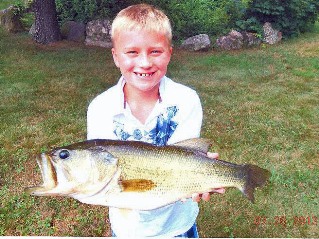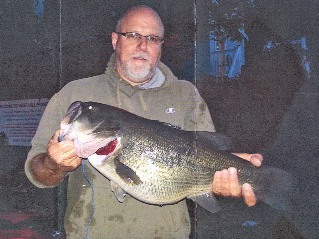Bass Management
Check out our current Bass Action Plan, a document that describes Connecticut's bass fisheries and the work being done to maintain and improve them.
 Largemouth and smallmouth bass are collectively the state’s most popular gamefish, generating 3.5 million fishing trips annually. Bass are also the main predators in all of Connecticut’s lakes and ponds and thus play a key role in maintaining healthy warmwater fish communities.
Bass in most waters are managed through statewide regulations (a standard 12-inch minimum length limit, 6-fish possession limit). However, in some Bass Management Lakes special length and creel limits designed to improve fishing have been put into place (1999 Bass Management Plan). Many of the Bass Management Lakes have 12-16” slot length limits, which means that bass below 12 inches and above 16 inches may be harvested, but none within the “slot” (12-16 inches). Slot limits protect large fish from harvest, while allowing harvest of abundant small fish. Harvesting surplus small bass reduces competition for food and allows the remaining bass to grow faster.
Largemouth and smallmouth bass are collectively the state’s most popular gamefish, generating 3.5 million fishing trips annually. Bass are also the main predators in all of Connecticut’s lakes and ponds and thus play a key role in maintaining healthy warmwater fish communities.
Bass in most waters are managed through statewide regulations (a standard 12-inch minimum length limit, 6-fish possession limit). However, in some Bass Management Lakes special length and creel limits designed to improve fishing have been put into place (1999 Bass Management Plan). Many of the Bass Management Lakes have 12-16” slot length limits, which means that bass below 12 inches and above 16 inches may be harvested, but none within the “slot” (12-16 inches). Slot limits protect large fish from harvest, while allowing harvest of abundant small fish. Harvesting surplus small bass reduces competition for food and allows the remaining bass to grow faster.
Check out Keeping Bass Alive, a short publication by B.A.S.S to help bass anglers ensure a successful release after catch.
Bass and other warmwater fish populations are monitored by night boat electrofishing, bass tournament weigh-in monitoring, and angler surveys. Most important bass lakes are sampled at least once every three years. Abundance, sizes and growth rates of warmwater fish species are tracked over time to detect trends in fish population health. Since 1987, the Lake and Pond Monitoring Project has sampled well over 200 water bodies statewide.
The DEEP Fisheries Division and the UConn Natural Resource Department partnered on an exciting bass research program focused on (Fishing Induced Evolution - FIE). FIE is a process where fishing actually causes genetic changes in fish populations by removing the boldest, most aggressive and active, and fastest growing bass (because they are the easiest to catch). This causes the remaining bass to be less active predators, which hampers their ability to control overabundant forage fish species, as well as making them harder to catch by angling. It may be possible to re-introduce desirable genes from “natural” bass populations to public lakes by stocking bass from unfished water supply reservoirs. This program is investigating the feasibility of this cutting edge management strategy.


Content last updated October 2022


